In this article:
Wheat flour is widely used to make breads and other staple dishes in many regions.
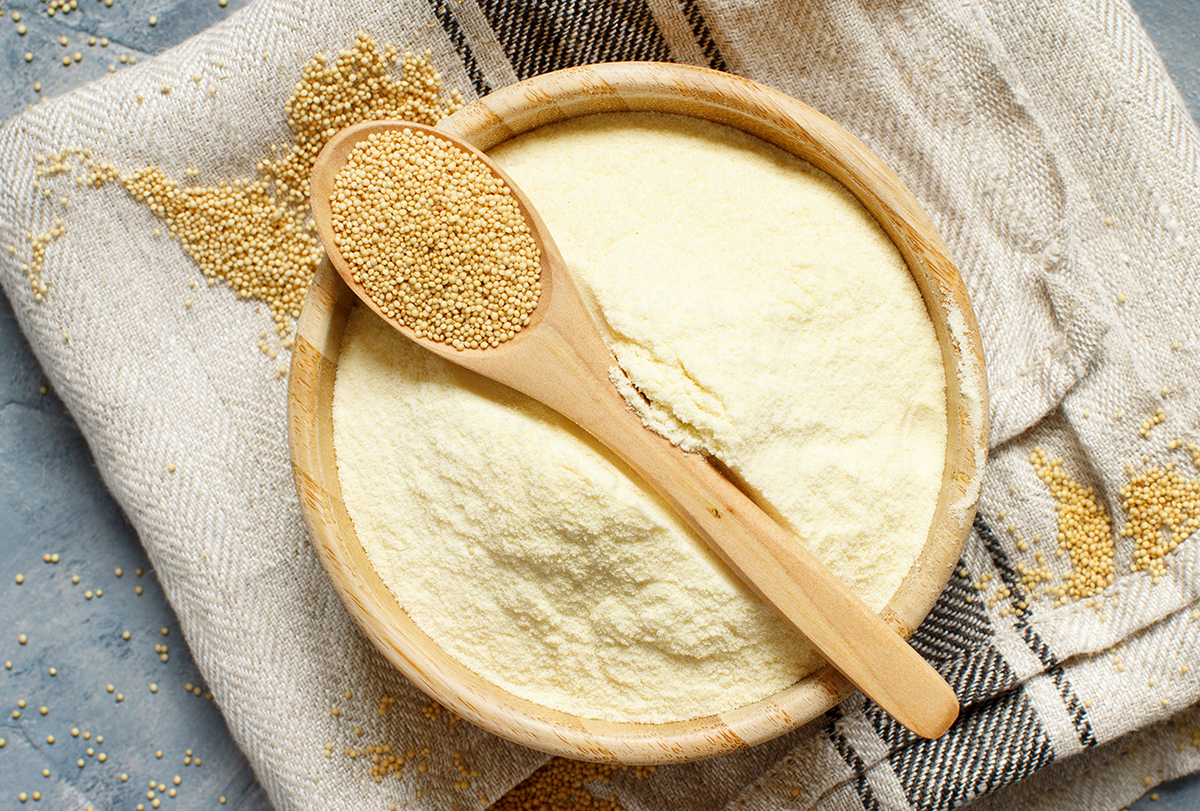
Domesticated over 10,000 years ago, it has successfully become a source of nutrition for many people. Some of wheat’s health advantages include benefits to heart health and a reduced risk of type 2 diabetes. (1)
People may choose to consume alternatives to wheat flour for various reasons:
- Presence of wheat allergy, celiac disease, wheat-related disorders, or nonceliac gluten insensitivity (1)
- To include a variety of cereals in their diet
- To add more nourishment to their meals
Whatever your reason for opting for wheat flour alternatives, it is important to remember that the elimination of wheat in the diet is not necessary unless you have a disease or allergy.
Alternatives to Wheat and Wheat Flour
Instead of wheat and wheat flour, you can consume the following.
1. Amaranth and amaranth flour
Amaranth is considered a pseudo-cereal and has been used for many years in various regions of the world.
Though starch is its main component, amaranth is a richer source of protein than others in the cereal group. It contains insoluble fibers such as lignin, cellulose, and hemicellulose that have beneficial effects on the digestive system. (2)
Moreover, amaranth flour is gluten-free and can be used in baking.
2. Oat and oat flour
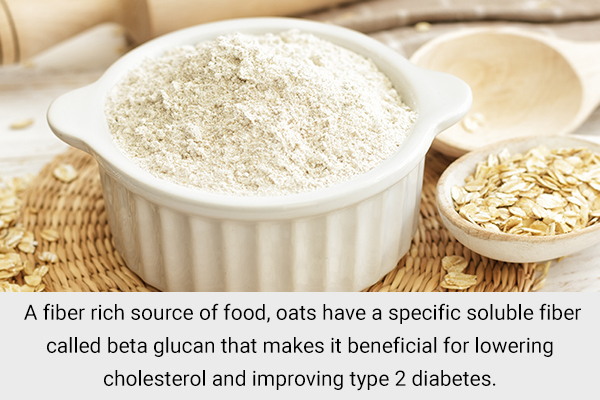
Oats have found their time in the spotlight and rightly so.
Oats are abundant in a specific soluble fiber called beta glucan, which is beneficial for lowering cholesterol levels and improving type 2 diabetes. It also has an impact on immunity and improves the diversity of gut microorganisms. (3)
The European Commission Regulation recommends oat and oat flour consumption by people with gluten allergy. (3)
3. Corn and maize flour
Maize and corn refer to the same cereal crop. The USA, Brazil, and China produce the vast majority of the total maize. (4)
Maize flour is often fortified with minerals, including iron and zinc, and vitamins, including folic acid, vitamin A, and other B vitamins. (4)
Maize is also gluten-free and can be used to make tortillas, chips, and some types of bread. (5)
4. Rice and rice flour
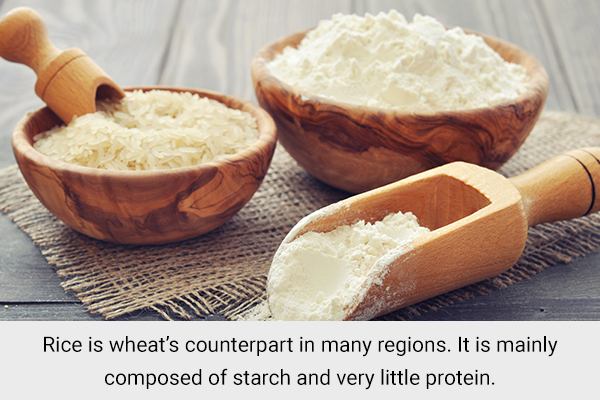
Rice is wheat’s counterpart in many regions. It is mainly composed of starch and very little protein. However, recently, protein-enriched rice flour is being utilized to make gluten-free baked goods. (6)
Rice flour has a soft texture and can also be included in the diet of the elderly. (7)
5. Barley and barley flour
Barley grains are tough to eat on their own due to their extremely high fiber content. The grain and its flour are used in breads and pastas.
Barley also contains beta glucan and is beneficial in reducing the risk of heart disease and improving type 2 diabetes. It can also reduce the risk of stroke by improving the levels of good cholesterol, making it a suitable food choice for the aging population. (8)
Barley flour is sometimes made from sprouted barley grains to improve its nutritional value, as the content of vitamins (B1, B2, C) and proteins increases upon germination. (9)
6. Millet and millet flour
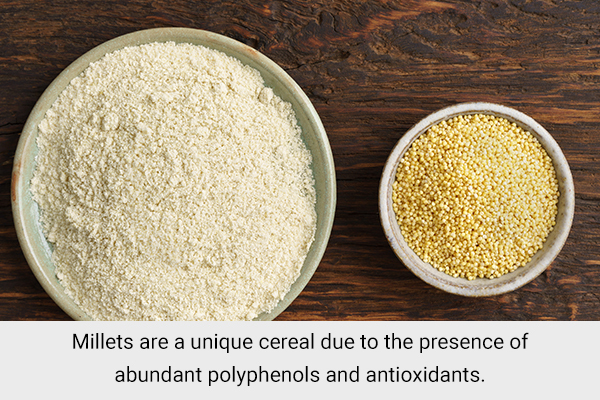
Millets are a unique cereal due to their abundant and health-beneficial polyphenols and antioxidants. Finger millet is more unique and abundant than pearl millet. (10)
The health benefits of millet include prevention of tissue damage and wound repair, lowering of cholesterol levels, reduction of risks of heart disease, and management of blood sugar levels. (10)
Millet flour is also gluten-free and can be used to make flatbreads and pancakes.
7. Chickpea flour
Chickpea is the third most popularly consumed legume in the world. Because it is a legume, it is gluten-free and can be used by people with gluten allergies. (11)
In addition to carbohydrates, chickpeas are chockful of protein, fats, vitamins, and minerals. (12) However, chickpeas have some antinutrients. Thus, they are usually germinated before milling into flour to improve the availability of nutrients. (11)
8. Buckwheat flour
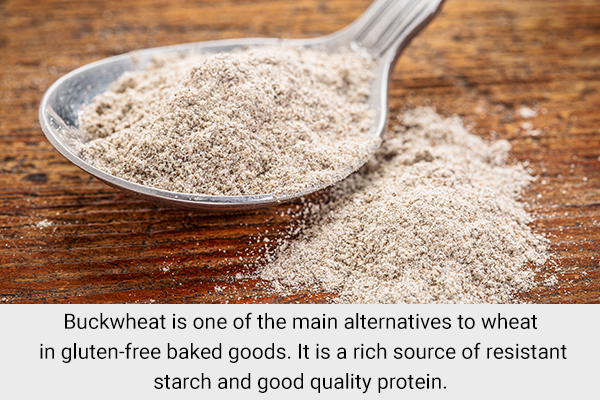
Buckwheat is one of the main alternatives to wheat in gluten-free baked goods. It is a rich source of resistant starch and good-quality protein.
Buckwheat also contains trace amounts of minerals including zinc, copper, manganese, iron, potassium, phosphorus, and magnesium. It is replete with fiber and polyphenolic compounds. (13)
Buckwheat breads can also be enriched with seeds to add some micronutrient value. (13)
9. Coconut flour
Coconut flour does not come under the cereal group and is used much lesser in gluten-free products than other flours.
Coconuts are nutrient dense with a high amount of protein, fats, and fiber along with potassium, iron, selenium, and magnesium. (14)
Coconut flour has a significant impact on heart health and can effectively reduce cholesterol levels. Due to its low glycemic index (the rate at which food increases blood sugar levels after eating), it can also be useful in managing blood sugar levels. (14)
Coconut flour can be combined with other gluten-free flours for cookies and cakes to reduce cost.
10. Almond flour
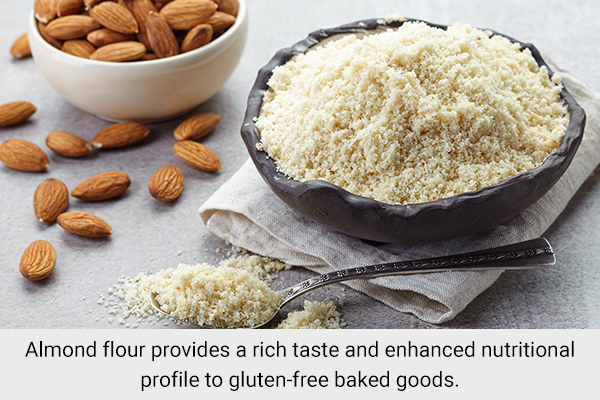
Almond flour provides a rich taste and enhanced nutritional profile to gluten-free baked goods. It is teeming with fiber, minerals, vitamin E, and polyphenols. (15)
Gluten-free products made from almond flour do have better acceptability by people.
Precautions to Consider
It is important to use gluten-free flours with care. If not cooked with proper hydration levels, gluten-free flours can cause stomach distress. Fortunately, many recipes online provide guidance on how to cook gluten-free flours.
In addition, precaution must be exercised with coconut flour and almond flour, as they are nut flours and their high fiber and fat content can also cause stomach distress.
Most-Asked Questions
Can tapioca flour or corn flour be used for gluten-free cooking/baking?
Tapioca flour is made from tapioca root, which is a rich starch. Similarly, corn flour is made by drying the starch of maize. While both of these flours can be used for gluten-free cooking, they add very little nutritional value to foods.
Can I use gluten-free flour as a low-carb alternative?
The only gluten-free flours that are low in carbs are chickpea flour, almond flour, and coconut flour. Most other flours are obtained from cereal groups, so they are still rich in carbohydrates.
Final Word
Gluten-free flours are being used as wheat alternatives for people with gluten and wheat allergies.
Choosing wheat flour alternatives that are rich in proteins and micronutrients can offer health benefits such as management of blood sugar levels, reduced risk of heart disease, and lower blood cholesterol levels.
Depending on your desired taste and cost, you have a variety of options to choose from. You can even combine different gluten-free flours for a richer nutritional profile.
- Was this article helpful?
- YES, THANKS!NOT REALLY


